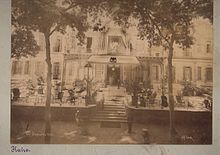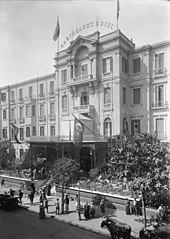Shepheard Hotel (Cairo)
The Shepheard Hotel was a hotel in Cairo that had existed since the 19th century and was destroyed during the great Cairo fire in 1952.
history
The hotel was taken over by Samuel Shepheard, a British, in 1841 and was soon named after him, but the hotel buildings themselves were even older: Napoleon had already had his private quarters here when his troops invaded Egypt. Under Shepheard's leadership, the hotel quickly became known and loved. It enjoyed the reputation of being the best hotel in Egypt, but this did not shy away from Mark Twain from the judgment that it was the second worst in the whole world. In 1873, Amelia Edwards described the hotel as a meeting place for illustrious people, while Blanche McManus particularly praised the view from the terrace of the hustle and bustle in front of the hotel.
In 1891 the hotel was destroyed by fire, but was rebuilt by the Nuremberg architect Johann Adam Rennebaum . From 1897 to 1905 the hotel belonged to the Compagnie Internationale des Grands Hotels , a subsidiary of the CIWL . The hotel had a garden and at times also a private zoo. It was heavily frequented by members of the British Army. On January 26, 1952, in anti-British riots, numerous western facilities in Cairo and the old hotel building were also destroyed.
The Shepheard Hotel was rebuilt in 1957 elsewhere, directly on the Nile . The house is owned by EGOTH (Egyptian General Company for Tourism and Hotels) and has been managed by the Rocco Forte Collection since November 2009 . The hotel has been closed since February 2014 due to extensive renovation.
Literary mentions
Stefan Zweig places an episode in the life of Colonel Balinkay from his novel Impatience of the Heart in the Shepheard Hotel. He describes the hotel as a luxury quarter. Scenes from the novel The English Patient from 1992 are also set in the Shepheard Hotel, but the corresponding scenes from the film of the same name were shot in the Hotel des Bains in Venice , as the new building from the 1950s was no longer suitable as a backdrop.
Perception in the local population
The old Shepheard Hotel was considered a den of sin by the local Egyptian population. The Egyptian hadith scholar Ahmad Muhammad Schākir (1892–1958) reports that in his childhood the hotel was referred to by the Egyptians as the “Shabat tavern” ( ḫammārat Šabat ) because of the amount of alcoholic beverages consumed there . More than 26 whiskey barrels are said to have been found in the destruction of January 26, 1952. Since he regarded the old hotel as an “ eyesore ” ( waṣmat ʿār ) for an “Islamic country” like Egypt, Shākir also rejected the new construction of the hotel that was planned at the time.
Web links
Individual evidence
- ^ Susanne Lorenz: The architectural language of luxury hotels in Dubai, UAE. Chapter 4. The hotel as a building task - hotel architecture. Dissertation, Freie Universität Berlin , February 2008, pp. 161, 176.
- ↑ The 'Death in Saqqara' Gallery: Shepheard's Hotel and the Winter Palace. BBC - History, February 17, 2011 (English).
- ^ Shepheard's Hotel. Peter Searle's website.
- ^ Albert Mühl, Jürgen Klein: Traveling in luxury trains. The International Sleeping Car Society. EK-Verlag, Freiburg im Breisgau 2006, p. 296.
- ↑ Christopher Xenopoulos Janus: A Strange and Unforgettable War-Time Experience. Hellenic Communication Service.
- ↑ a b Rocco Forte Collection signs contract for hotel in Cairo. Press release from November 5, 2009 ( Memento from September 10, 2012 in the web archive archive.today ).
- ^ Announcement on the hotel's homepage ( Memento from December 1st, 2017 in the web archive archive.today ).
- ↑ Hotel des Bains in Venice: The Grand Hotel with the charm of the Belle Epoque. Reisebericht-Blog.com.
- ↑ Cf. Ahmad Muḥammad Šākir: Ḥukm al-ǧāhilīya . Maktabat as-Sunna, Cairo 1992. pp. 50-53.
Coordinates: 30 ° 2 ′ 32 " N , 31 ° 13 ′ 54.3" E

